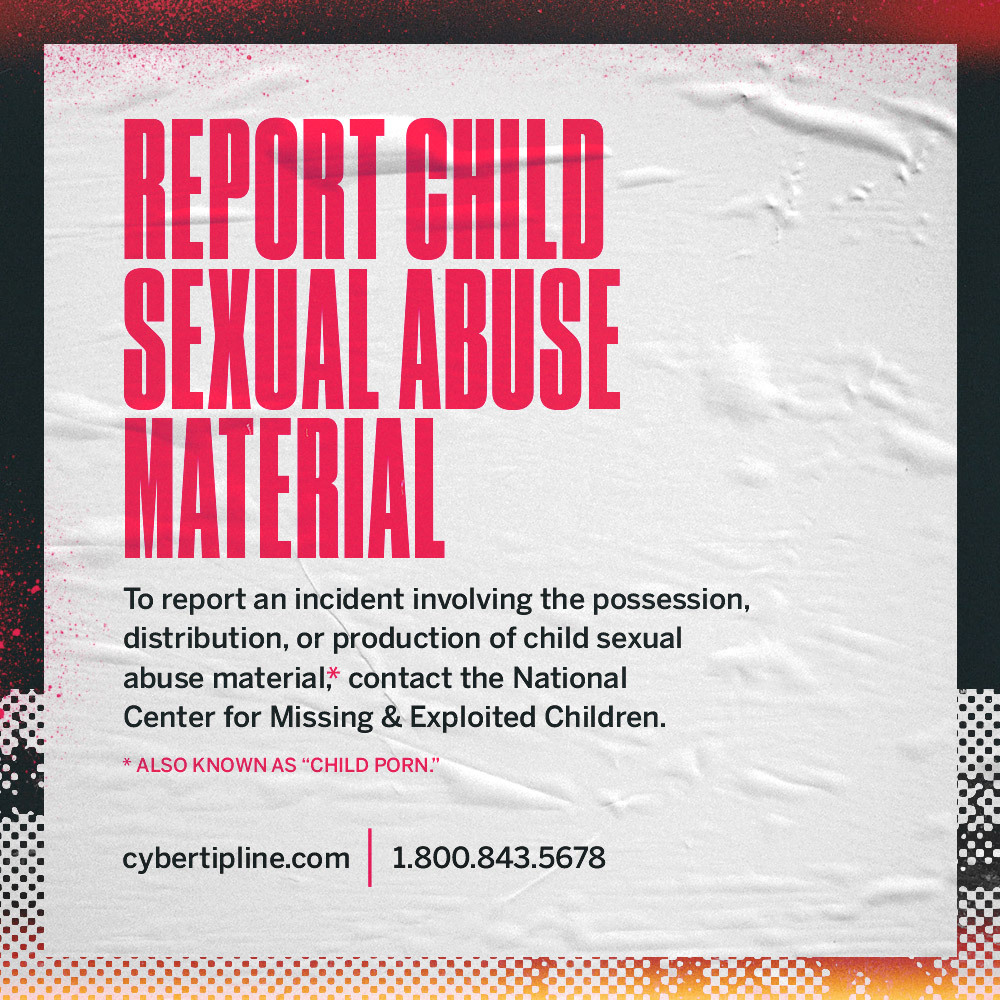It’s no secret that, while the internet has been an enormous and efficient connector of people across the globe, the internet has also fueled and perpetuated a number of huge issues in our society.
One of the most prominent of these negative impacts is the child sexual exploitation industry’s dark relationship with the internet.
Before the internet’s inception, it was both more difficult and riskier for sexual predators to find potential victims and sell them to clients. Now, with the growth of technology, finding and selling human beings has become as simple as a few clicks.
And while it’s not a guarantee that every child on the internet will come in contact with a predator who wants to kidnap them or physically control them and exploit them, it absolutely does happen.
For finding potential victims, sexual predators now have the ability to anonymously identify vulnerable youths by scoping out their social media profiles, initiating contact utilizing inaccurate—or even completely fake—profiles, and beginning the grooming process.
Moreover, sexual predators have the ability to build a sense of trust with their target that may not have been possible face to face; they can use flattery and phrases to make the child feel understood and important.
On the other side of the coin, sexual predators can compel their victims to act by gaining power over them. The predator gains this power by stalking or monitoring accounts, sending threatening messages, or spreading rumors about their victims.
With regard to selling victims, it’s as simple as uploading a craigslist ad once they’ve made contact with the minor. Sexual predators will find “dating” and “personals” sites that offer a little more than they suggest, and then upload an ad with a name, short description, phone number, and explicit photos of their victim. No joke, that’s all it takes to get the calls rolling in.
Related: How To Report Child Sexual Abuse Material If You Or Someone You Know Sees It Online
Thankfully, the world has started taking note and has begun to respond. More specifically, as sexual predators have begun to use technology for their exploitative purposes, the technology industry has used its own technology to fight back.
Here’s how one international company is doing just that.
Microsoft has created an online tool to fight sex trafficking
Bill Gates’ multinational technology company, Microsoft, is one of a number of technology companies to have taken a stand against online child exploitation and abuse.
In the last few years, Microsoft created an automated system designed to detect sexual predators trying to groom children online.
Related: 8 Popular Conspiracy Theories About Sex Trafficking, Debunked
The system’s name? Project Artemis. What it does is even cooler than its name.
Project Artemis’ job is to spot patterns of communication in conversations. Then, based on those patterns of speech and the words being used in the conversation, the system will assign a rating for the likelihood that one of the participants is trying to groom the other.
The rating part of the system is incredibly useful because it allows those using the system to flag higher risk conversations for human moderator review and, in some cases, to immediately send conversations that exhibit an imminent threat to law enforcement.
In tracking the movements, manipulative language, and grooming techniques used by sexual predators in flaggable conversations, the system will also provide experts with more information on how sexual predators operate online—which will allow Microsoft to increase the accuracy of the system’s flagging mechanism.
Related: Want To Help Fight Child Sex Trafficking? Know These 9 Acronyms And 5 Facts
And while, according to the company’s chief digital safety officer, Courtney Gregoire, Microsoft has only been utilizing these techniques for several years on its own products, including on Skype and its Xbox platform, it has invited further contribution and engagement from other technology companies and organizations with the goal to improve and refine the system further.
In order to know how to improve and refine the system though, we first need to talk about how it works—let’s dive in.
How Project Artemis works
So, then, how does Project Artemis actually work? Well, the truth is, we don’t really know. In fact, very few outside of Microsoft know, but that’s actually the key to the whole thing.
Why?
Because if Microsoft explains the precise words or patterns the tool hunts for, sexual predators could potentially adjust their behaviors to hide their activities and, essentially, rendering Project Artemis useless.
Related: Apple Fights Child Abuse Images By Scanning Users’ Uploaded iCloud Photos
While the system still has some risks in that it might throw up false positives, since automated systems still struggle to understand the meaning and context of language, and in that it assumes that users permit their private communications to be read, Project Artemis has enough merit to make sexual predators think twice before they use online chat functions for exploiting children.
Great, right?
Thankfully, Microsoft and Project Artemis are not alone. We’ve written other articles on other technology companies like Apple, who has been fighting the disturbing increase of child exploitation imagery by screening images that are backed up to its storage service, and WhatsApp, which banned over 130,000 WhatsApp accounts in a 10-day period for violating its policies against child exploitation.
But technology companies shouldn’t be fighting alone—each of us can step up, too.
Related: Uncovering The Child Porn Distribution Epidemic On WhatsApp
Why this matters
As Gregoire puts it, “Combating online child exploitation should and must be a universal call to action.”
While Project Artemis has proven itself effective, it is “by no means a panacea.” In other words, one online tool doesn’t solve the worldwide problem of online child sexual exploitation and abuse.
Related: Reports Of CSAM Increased In 2020—Why Was So Much Of It Created By Minors Themselves?
For some people, the sheer complexity and global nature of the issue would make them feel like they can’t make a real difference. But not Microsoft. The company has embraced a “multi-stakeholder model to combat online child exploitation that includes survivors and their advocates, government, tech companies and civil society working together.”
And we must do the same to stop and prevent online child exploitation once and for all.
Click here to read more about how child exploitation and mainstream adult pornography are connected.
To report an incident involving the possession, distribution, receipt, or production of child pornography, file a report on the National Center for Missing & Exploited Children (NCMEC)’s website at www.cybertipline.com, or call 1-800-843-5678.
Your Support Matters Now More Than Ever
Most kids today are exposed to porn by the age of 12. By the time they’re teenagers, 75% of boys and 70% of girls have already viewed itRobb, M.B., & Mann, S. (2023). Teens and pornography. San Francisco, CA: Common Sense.Copy —often before they’ve had a single healthy conversation about it.
Even more concerning: over half of boys and nearly 40% of girls believe porn is a realistic depiction of sexMartellozzo, E., Monaghan, A., Adler, J. R., Davidson, J., Leyva, R., & Horvath, M. A. H. (2016). “I wasn’t sure it was normal to watch it”: A quantitative and qualitative examination of the impact of online pornography on the values, attitudes, beliefs and behaviours of children and young people. Middlesex University, NSPCC, & Office of the Children’s Commissioner.Copy . And among teens who have seen porn, more than 79% of teens use it to learn how to have sexRobb, M.B., & Mann, S. (2023). Teens and pornography. San Francisco, CA: Common Sense.Copy . That means millions of young people are getting sex ed from violent, degrading content, which becomes their baseline understanding of intimacy. Out of the most popular porn, 33%-88% of videos contain physical aggression and nonconsensual violence-related themesFritz, N., Malic, V., Paul, B., & Zhou, Y. (2020). A descriptive analysis of the types, targets, and relative frequency of aggression in mainstream pornography. Archives of Sexual Behavior, 49(8), 3041-3053. doi:10.1007/s10508-020-01773-0Copy Bridges et al., 2010, “Aggression and Sexual Behavior in Best-Selling Pornography Videos: A Content Analysis,” Violence Against Women.Copy .
From increasing rates of loneliness, depression, and self-doubt, to distorted views of sex, reduced relationship satisfaction, and riskier sexual behavior among teens, porn is impacting individuals, relationships, and society worldwideFight the New Drug. (2024, May). Get the Facts (Series of web articles). Fight the New Drug.Copy .
This is why Fight the New Drug exists—but we can’t do it without you.
Your donation directly fuels the creation of new educational resources, including our awareness-raising videos, podcasts, research-driven articles, engaging school presentations, and digital tools that reach youth where they are: online and in school. It equips individuals, parents, educators, and youth with trustworthy resources to start the conversation.
Will you join us? We’re grateful for whatever you can give—but a recurring donation makes the biggest difference. Every dollar directly supports our vital work, and every individual we reach decreases sexual exploitation. Let’s fight for real love:





